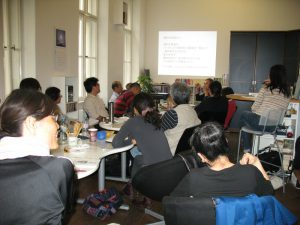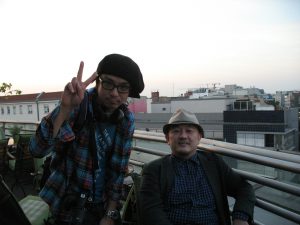今回から数回に渡って 2014-09-13 に行なわれた廃炉についての SNB での勉強会の様子のメモをこの Blog にて報告いたします.第1回目はどうしてこの勉強会が行なわれたかについてです.
1. なぜ廃炉の話なのでしょうか
福島の事故の後,破壊された原子炉を廃炉にする,あるいは寿命がきてしまった原子炉を廃炉にするという話を聞きます.物が使えなくなった時にどうするのかという話ですが,原子炉の場合はどうなのでしょうか.考えてみるとゴミに出すとかリサイクルするとかいう話とはちょっと違うようです.原子炉にも必ず寿命が来ますので,原子炉が存在する以上廃炉は必ずやってきます.そこで素朴に廃炉とはどんなものかを知りたいなと考えた SNB (Sayonara Nukes Berlin) の何人かが,ジャーナリストとしてこの問題を長い間追いかけているふくもとさんにお願いしてお話を伺いました.この話がでた時,ふくもとさんは「廃炉のことを知ると原発がどういうものがわかってくる」とおっしゃられ,快く講師を引き受けて下さいました.図 1 がその様子の写真です.

このメモはその勉強会での記録を記録者の私が理解したようにまとめたものです.
1.1 講師: ふくもとまさお氏
現在フリージャーナリストとして活躍なさっているふくもとさんは,1980年代には東ドイツに在住しておられました.その時のチェルノブイリ原発事故をきっかけにそれ以降,原発問題に関心を持たれたそうです.ふくもとさんは原発問題に関しての著作[Fukumoto 1] があり,ドキュメンタリーの制作[Fukumoto 2]にもかかわられています.
1.2 廃炉の題材
今回は.世界でも最大規模の廃炉がドイツのグライフスヴァルトで行なわれているということで,これを例とした廃炉の話をふくもとさんにおうかがいしました.
2. 廃炉とは何ですか
2.1 原子炉と廃炉
原子炉とは基本的には湯沸し器であり,その湯沸し器で作った蒸気でタービンを回して巨大な自転車のダイナモのような発電機をまわして電気を作ります.お湯をわかす時に核分裂のエネルギーを利用するので原子力発電と言います.もし石油や石炭で蒸気を作れば火力発電になります.この湯沸し器が原子炉です.この原子炉が危険な放射性物質で汚染されるため,これを安全に処理する必要があります.その作業をここでは廃炉作業と呼びます.
2.2 廃炉のはじまりと終わり
廃炉とは原子炉のあった原子力発電所の土地を整地して緑化するまでの作業のことです.しかし,廃炉は1つのステップでしかなく,廃炉が終われば全て完了ではありませんでした.廃炉の後には最終的な廃棄物が残ります.その話は廃炉の後の話で,ここでは述べません.それはまた他の勉強会ということになるかもしれません.
廃炉は炉のあった土地の緑化作業終了で終わります,では廃炉はいつからはじまるのでしょうか?
廃炉は原子炉の設計段階からはじまります.放射性物質に汚染された炉を安全に解体できるよう,炉を設計しておく必要があります.たとえば,炉を格納容器や建物から安全に取り出すことができるように設計しておかないと後でその処理が難しくなります.
ドイツでは,設計段階で圧力容器をどう取り出すかなど廃炉の基本的なコンセプトが考えられていないと,原発の設計許可はおりません.ただし日本ではこの条項は必須ではないようです.(記録者注: 設計図が散逸したり古くて読めない,解体は考慮されていなかったという問題が指摘されている番組があります[NHKスペシャル2009.10.11])
3. 廃炉の方法
廃炉の方法には大きく分けると以下の2つがあります.
- 解体撤去(即時解体撤去)
- 安全貯蔵(これを完全密封と遮蔽管理に分けることがあります)
それぞれについて見ていきましょう.
3.1 (即時)解体撤去
原子炉の運転を止めてからすぐに原子炉の解体をはじめる方法です.この方法の利点と欠点は:
- 利点: 現場を知る作業員がいるために作業が有利
- 欠点: 汚染度が高い
原子炉というものは規格化されて大量生産されているものではなく,プラント毎にカスタマイズされています.そのために現場の状況を知る作業員がいることは解体の作業をすすめる時に有利になります.
原子炉の運転を停止した直後は汚染度も高いため,作業そのものが難航します.これにはロボットを利用するなどの工夫が必要です.
3.2 安全貯蔵
安全貯蔵法は,放射線汚染が下がるまである期間(30年〜)待つ方法です.以下がこの方法の利点と欠点です.
- 利点: 作業時の汚染度が相対的に低い
- 欠点: 現場の状況を知っている作業員がいない.
この方法は即時解体撤去法と比べれば汚染度が低く作業も容易になります.ただし完全に汚染が除けるわけではないので相対的に容易ということです.
一方で通常 30 年,あるいは50年以上の貯蔵期間を経るために,現場の状況を知る作業員は期待できません.
3.3 第1回目のまとめ
形ある物はいつか寿命がきます.原子炉も然り.でも,どうするのか聞いたことがありません.しかし放射性物質のかたまりである原子炉の燃料や,それを保持していた容器を普通に捨てるわけにはいかないことはさすがに私にも想像がつきます.今回は廃炉とは何であり,どのように行なわれるかの話をしました.私が関心のあるのは,「廃炉ってそもそもできるのか,どうするのか」「いったいいくらかかり,誰が負担するのか」「廃棄物はどうするのか」などです.今回は最初の疑問,廃炉はできるのか,どうするのかに答えたものでした.廃炉は不可能ではないらしいが様々な困難さがあることはわかりました.
以前の能天気な私ならば「まあ,誰か考えているさ」位に考えていたかもしれません.しかし私が個人的に福島で思い知らされたのは「誰も考えていない」あるいは「私は責任をとりません」という意味の「想定外」という言葉の連呼でした.私は「想定外で片づけられるのは御免だ.」と個人的に思いました.福島は「誰かが考えているさ,なんとかなるさ」と思っていた能天気な私に「目を覚ませ」という強烈な一撃を浴びせました.しかし,目を覚ましていったいどうするのか,このまま真の破局までのつかの間でも,ぼんやり寝ていた方が幸せではないか.どうしてこんな面倒なことになったのだ,とまだまだ能天気な自分がでてきます.その一方,国土の一部とて失うエネルギー源の意味とは,子どもを,命を危険にさらして冷房を使い,インターネットを使う意味とは,を考えてしまいます.
しかし,ではいったい私に何ができるのか? たいしたことはできないでしょう.でも能天気な私はまたこうも思いました.「私に何かが変えられるとは思わないけれども,別に何があるのか調べてちょっと考えても悪くはない.何かできればもうけもの」そこで,まずは何が進行しているのかの一部でも知りたいと思って勉強会に参加しました.
第2回では私の他の疑問,廃炉にかかる期間と費用,そして廃炉の廃棄物の話を予定しています.
参考資料
- [Fukumoto 1] ふくもとまさお,ドイツ・低線量被曝から28年 — チェルノブイリはおわっていない, 言叢社,2014, ISBN-13: 978-4862090478
- [Fukumoto 2] 日本テレビ, NNNドキュメント’13, 活断層と原発、そして廃炉, http://www.ntv.co.jp/document/news41_2.html,2013
- [NHKスペシャル2009.10.11] NHK スペシャル 原発解体〜世界の現場は警告する〜 http://www.nhk.or.jp/special/detail/2009/1011/
廃炉の話をしようや:勉強会の様子” width=”300″ height=”225″ />
Fig1. Let’s talk about nuclear decommissioning: meeting snapshot
This blog article is a summary of my understanding of the discussion.
1.1.1 Lecturer: Masao Fukumoto
Fukumoto is a free journalist. He lived in East Germany (Deutsche Demokratische Republik) in the mid 80s. There was the Chernobyl nuclear incident. For him, that was an on-going disaster experience and that was the clue to follow the nuclear energy problems. He is the author of a book [Fukumoto 1] dealing with the radioactive contamination problem of Chernobyl. He is also one of the creators of a TV documentary about nuclear decommissioning [Fukumoto 2].
1.1.2 Example of nuclear decommissioning
In the discussion meeting, Fukumoto suggested to talk about Greifswald nuclear power plant as an example of a nuclear decommissioning since it is currently the largest nuclear decommissioning project in the world.
1.2 What is nuclear decommissioning?
1.2.1 Nuclear reactor and nuclear decommissioning
A nuclear reactor is fundamentally the same as a huge kettle. We generate high pressure steam by the huge kettle and drive a steam turbine to generate electricity. Since we used nuclear fuel to boil the water in the kettle, we call the resulting energy nuclear energy. This huge kettle is called a nuclear reactor. Since this nuclear reactor uses highly radioactive dangerous substances, a nuclear reactor should be processed and appropriate safety measures have to be taken before trashing it. This process is called nuclear decommissioning.
1.2.2 The start and the end of a nuclear decommissioning
A nuclear decommissioning is a process to restore the site’s “greenfield” status. Radioactivity surveillance for the area should not be required after the decommissioning. However, a nuclear decommissioning is only of the cleanup. Nuclear decommissioning produces radioactive waste and processing radioactive waste was beyond the scope of the meeting. We may have another discussion meeting for the topic.
When the area is back to a greenfield status, then that is the end of nuclear decommissioning. So, when does a nuclear decommissioning start?
The nuclear decommissioning started in the design phase of the plant and the reactor. To make the decommissioning process safe, we need to design a reactor that can be safely decomposed. For instance, we need to build a reactor that can be carried by a crane (or by some kind of machine) to remove it from the building. Otherwise the process would become difficult.
In Germany today, the government cannot give permission to build a reactor if the designer of the reactor didn’t consider the concept of nuclear decommissioning (East Germany (Deutsche Demokratische Republik) might not have had this regulation.) However, including the decommissioning concept in the reactor design seems not necessary to build a reactor in Japan (Recorder’s footnote: [NHK special document 2009.10.11] shows that a Japanese company lost some of the design plan of their reactor, and the remaining design plan is too old to read it. The regulations didn’t require to keep the plans.)
1.3 The methods of nuclear decommissioning
There are mainly two methods of nuclear decommissioning:
- Immediate dismantling
- Safe enclosure (Sometimes this method is further divided into Safe enclosure and Entombment.)
Let’s see them one by one.
1.3.1 Immediate dismantling method
This method starts decomposing the reactor directory after the power plant shuts down. The pros and cons of this method are:
- Pros: There still are the workers who know the plant details. This is an advantage for the decomposing operation.
- Cons: The radioactive contamination level is high
Nuclear reactors are not standardized. Each plant is highly customized. Therefore, availability of the workers who know the plant is an advantage to operate the decommission.
On the other hand, immediately after the shutdown of the reactor, the radioactive dosage is still high. This makes the decommissioning operation difficult. We need to develop some kind of technology, for instance, using a special robot.
1.3.2 Safe enclosure method
This method first keeps the reactor in storage and waits for some period (it is usually more than 30 years). The pros and cons of this method are:
- Pros: The radioactive dosage is relatively low when operating the decommission
- Cons: The workers who know the plant details are no longer available
The process is relatively easier than the immediate dismantling method since the radioactive dosage will be relatively low. But we can never completely remove the radioactive contamination in several decades, the difficulty is only relatively lower.
On the other hand, this method needs more than thirty to fifty years of storage time, we usually cannot expect the help from the workers who know the plant details.
1.4 Part 1 Summary
Everything on the earth has a limited lifetime. A nuclear reactor is not an exception. However, I haven’t heard what happens when a reactor reaches the end of its design lifespan. I can easily imagine that we cannot trash it like a piece of paper.
In this article, we talk about what is a nuclear decommissioning and how could we do that. My main concern is actually “Is it really possible and how?”, “How much does it cost? Who pays that?”, and “What should we do about the nuclear waste?” The first question has been answered in this article: It might be possible, but it is difficult.
Before the Fukushima disaster, I was less concerned about the energy problem. I simply thought, “Anyone should have thought through it.” However, what we saw in the Fukushima disaster was “No one thought about it.” and “No one wants to take responsibility.” The responsible people told us, “it’s unexpected.” One of the strangest logic was that “It’s unexpected, therefore no one takes responsibility. It is a natural disaster.” I can hardly understand that a nuclear reactor explosion is a natural disaster. I personally thought, I don’t want to die with the reason of “unexpected.” The Fukushima disaster opened my eyes, it said “Hey you, wake up!” But I don’t know what I can do about this. Maybe it is better if I keep sleeping, ignoring the Fukushima disaster. However, I also know that if everyone keeps sleeping, the next disaster is unavoidable. Whether I am ignoring the problem or not, Japan has around 60 nuclear reactors. That fact always remains. I asked myself, “Why did this happen to us?” A part of me still wants to go back to be a person who doesn’t think about this problem. On the other hand, I cannot stop thinking what Fukushima really means: What does it mean to use an energy source that forces us to lose a part of our country? What does it mean to use air conditioning and to access the internet powered by nuclear reactors which endanger the life of people, especially children’s lives.
Then, what can I do about it? Maybe I can do nothing. I still would like to ignore the problem since thinking is hard. However, I also said to myself, “If I cannot change anything, does it really matter? It isn’t hard to try to think about this problem. If I can achieve something, that’s pure luck, but if not, so what?” So I started researching the energy problem. It’s fine even if I can only understand just a part of it. I just don’t want to hear the excuse again, “Sorry, that is a unexpected natural disaster, we can do nothing for you.”
In part two of this article, I would like to look into my next questions, “How much does the nuclear decommissioning cost, and how long does it take?”, “What should we do with the nuclear waste?”
References
- [Fukumoto 1] ふくもと まさお, “ドイツ・低線量被曝から28年 –チェルノブイリはおわっていない”, 言叢社, 2014 (Masao Fukumoto, “Germany, 28 years after the low level dosage exposure — Chernobyl has not been ended”, Gensou publishers, 2014, ISBN-13: 978-4862090478)
- [Fukumoto 2] 日本テレビ, NNNドキュメント’13, 活断層と原発、そして廃炉, http://www.ntv.co.jp/document/news41_2.html, 2013 (Japan TV, NNN document’13, Active fault, nuclear power plant, and nuclear decommission, http://www.ntv.co.jp/document/news41_2.html, 2013)
- [NHK special document 2009.10.11] NHK スペシャル 2009.10.11, 原発解体~世界の現場は警告する~ http://www.nhk.or.jp/special/detail/2009/1011/ (NHK Special, Decompose the nuclear plants: the field of the world warns us, http://www.nhk.or.jp/special/detail/2009/1011/)
数ヶ月前、ドイツの国際放送Deutsche Welleのラジオ番組を作るという大学院生のプロジェクトで取材を受けた。ケルン大学に留学しているというメキシコ出身の彼女は、数あるトピックの中から、東日本大震災・原発事故のことを選んでくれたようだ。インタビューの最後に、震災を通して学んだことは何ですか?と聞かれ、私の口から出たことは、
「政府は信用できない、ということです」
だった。
そんな質問が来ると思っていなかったから、そういう答えを準備していたわけじゃない。
ここのところ、“今報道されていることが本当のことかどうかわからない”ことがわかってきたこと、報道を鵜呑みにして思考停止してはいけないという思いを抱き始めたことが、こうしてとっさに言葉に出たのかも知れない。
そして先日、ああ、やっぱりそうだ・・・と思わされる話を聞いた。
9月、国際シンポジウム* に参加するため来独したインディペンデント・ウェブ・ジャーナル(略称:IWJ)代表でジャーナリストの岩上安身さんがベルリンに取材のため立ち寄り、私たちのグループのために時間を取っていろいろお話ししてくださった。
(*ドイツ、エアランゲンでのシンポジウム「災害、デジタル公共性、民主主義の未来」に同じく出席したジャーナリスト高松平蔵氏の報告→ http://toyokeizai.net/articles/-/48727 )
岩上さんは日本のテレビ番組でもコメンテーターとしておなじみだそうだが、私は岩上さんとIWJのことを『自由報道協会が追った3.11』を読んで知っていたので、直接お話が聞けることはうれしい機会だった。
岩上さんは、これまでのご自身の豊富な取材経験から得た鋭い洞察力で、今世の中で起きている出来事を、一般メディアであまり報道されない視点で続々と切っていき、私も頭が追いつくように必死に聞き入った。お話の内容があまりにもボリュームがあったので、主要なトッピックをざっと箇条書きにしてみる。
***
TPPで日本はアメリカの経済植民地になる
新自由主義は一部にしか利益をもたらさず国内投資なし、一層格差を広げる、刹那的
安倍首相や竹中平蔵氏などは新自由主義者である
米「ジャイアン」と日「スネオ」(←岩上氏命名)的関係の従米政権
アメリカの日本改造の意図をあからさまに言及する米政治家の発言や報告書の存在
エネルギーと覇権、軍事、通貨
ロシアとヨーロッパ、アメリカの関係
ウクライナのネオナチ、ウクライナ戦争の真相、アメリカの偽証
マレーシア航空墜落事件やISISの背後にあるもの
PNAC(アメリカ新世紀プロジェクト)とアメリカのネオコン
***
話の中で、岩上さんが 「あることがないことになっている」とされる、と言った。
その言葉を聞いて、福島の放射能汚染、被曝についてもぴったりと当てはまるな、と思った。
原発のことだけではなく、「慰安婦」をはじめとする歴史認識問題、集団的自衛権行使のための憲法解釈変更などについても、今の日本政府やそれに迎合するメディアには、
「あることがないことになっている」
「問題のすり替え」
「なし崩し的に」
この3語が当てはまると思われることが、あまりにも多くないか。
日本の「記者クラブ」は大手新聞社の記者のみが許され、フリーランスのジャーナリストは入れてもらえないそうだ。それゆえ、現在の日本の大手新聞、テレビというのは、自由な報道がなされない体質になっていきてるようだ。だから、IWJのような、独自に取材をし、インターネットで情報を配信する独立したメディアがこれから真実を伝えていくキープレイヤーになっていくに違いない。
人はそれぞれ自らの経験や見聞したことから物事を判断するが、私もそのプロセスを経た上で、岩上さんから聞いたことに納得する部分が多々あり、一般に報道されていることをそのまま信じていたら、とんでもない誤った理解をしていたところだ、と思わされた。
いろいろお話を聞いて、今の日本像や世界像が私の中でなんとなく浮かび上がってきた。
このままじゃ、いけない。
IWJ代表の岩上安身さん(右)と、スタッフの原さん in Berlin
※インディペンデント・ウェブ・ジャーナル(略称:IWJ)は、ジャーナリスト岩上安身氏が2010年12月に設立した、インターネットを活用し、市民に根ざした新しいジャーナリズムのありかたを具現化するインターネット報道メディア。岩上氏の本拠地として、また、岩上安身の提唱する「兼業ジャーナリスト(市民ジャーナリスト)」「中継市民」の活躍の場として、日々、情報を発信している。
その活動を支えているのが一般市民からの会費やカンパだが、まだまだ運営費全体をカバーするほどの収入はないそうだ。今の日本に危機感を覚え、自分に何ができるのか?と悶々としている人は、IWJの会員として、こうした真実を伝える独立したメディアの存続を支えていくことも一つだろう。
ホームページでは、配信された動画のタイトルが並ぶ。それを目にすれば、今あなたが本当に知らなければならないことが見えてくるだろう。 http://iwj.co.jp/
